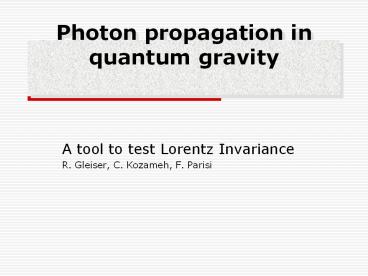Photon propagation in quantum gravity - PowerPoint PPT Presentation
1 / 17
Title: Photon propagation in quantum gravity
1
Photon propagation in quantum gravity
- A tool to test Lorentz Invariance
- R. Gleiser, C. Kozameh, F. Parisi
2
Physics at the end of the XIX century
- Lord Kelvin reflecting on the status of physics.
- I am lucky to have seen all the major
accomplishments in Physics! - Maxwells theory to explain the ondulatory
nature of light. - Newtons theory to explain celestial motion.
- Thermodynamics to explain the behavior of
systems. - All that is left is to solve specific problems.
- Small problem lack of invariance of Maxwell
theory under the Galilean group. It was thought
the equations were valid on a reference frame at
rest with respect to the ether. The Michelson
Morley experiment was designed to measure the
speed of the earth with respect to the ether.
3
Einsteins five papers of 1905
- "On a heuristic viewpoint concerning the
production and transformation of light." - (light quantum/photoelectric effect) (17 March
1905)Annalen der Physik, 17(1905), pp. 132-148. - "A New Determination of Molecular Dimensions"
(Doctoral dissertation) (30 April 1905). - Annalen der Physik, 19 (1906), pp. 289-305.
- "On the motion of small particles suspended in
liquids at rest required by the molecular-kinetic
theory of heat." (Brownian motion paper) (11 May
1905)Annalen der Physik, 17 (1905), pp. 549-560.
4
Einsteins five papers of 1905
- " On the electrodynamics of moving bodies"
- (Special relativity) (30 June 1905) Annalen der
Physik, 17 (1905), pp. 891-921. - " Does the inertia of a body depend on its energy
content?" - (Emc2) (27 September 1905).
- Annalen der Physik, 18 (1905), pp. 639-641.
5
Einsteins fourth miraculous paper
- Lorentz invariance is arguably the most
fundamental principle in Physics. - In 1905, Albert Einstein, inspired by the
Michelson and Morley's experiment, presented his
theory of special relativity and redefined our
notion of space, time and gravity.
6
Einsteins fourth miraculous paper
- Today physicists are doing reruns of old
experiments with extraordinary precision testing
the constancy of the speed of light. Nature 427,
482 - 484 (2004) - Recent claims coming from the two leading
candidates for a quantum theory of gravity
challenge this basic symmetry. - Their predictions could be observed with present
level of technology. - If true, there would have to be a mayor revision
of our understanding of the physical processes. - In this talk we review these claims and show that
Lorentz invariance is preserved.
7
Possible Lorentz violating effects
- Superstrings. Very energetic photons interact
with the quantum structure of the space-time.
Consequence their speed is lower than that of
less energetic photons. G. Amelio-Camelia, et al,
Nature 393, 793 (1998). - Loop Quantum Gravity. Left and right helicity
photons travel at different speeds. - R. Gambini, J. Pullin, Phys. Rev. D 59, 124021
(1999).
8
Possible Lorentz violating effects
- Photons emitted simultaneously will separate as
they travel through space. Time delay seen by
observer - Physical processes
- will mask this effect.
- Unlikely to be observed
9
Another Lorentz violating effect.
- For linearly polarized photons the polarization
direction depends on the energy of the photon. - R. Gleiser, C. Kozameh, Phys. Rev. D 59, 124021
(2001). - This effect has been used to set an upper bound
for visible light and for
gamma rays.
10
Is Lorentz invariance violated?
- None of these predicted effects have been
observed. Is Lorentz invariance really violated
at the order of approximation of these
calculations? - Superstring model difficult to follow.
Nevertheless the dispersion relation arises from
the equation - where vi is the speed of the receding string.
- This equation says that any photon follows the
same null geodesic regardless of its energy.
11
Coupling radiation fields with gravity
- The loop quantum gravity model has a more
standard approach. It is thus worth reviewing the
relevant fields involved in this interaction - Classical theory Lagrangian and Hamiltonian
formulation - Quantum theory the quantum operators.
- Semiclassical approximation
- - Effective interaction Hamiltonian.
- - Field equations
12
Classical source-free Maxwell fields
- Maxwell field
- Lagrangian density
- Euler-Lagrange equation
- Local (t, xa) coords.
13
Hamiltonian formulation
- Conjugate momentum to Aa
- Hamiltonian density
- Hamilton equations
14
The quantum operators and states
- The quantum operators are
- where the canonical pairs satisfy the c.c.r.
- The Hamiltonian density operator reads
- The semiclassical states
15
The effective Hamiltonian
- Taking expectation values of H with semiclassical
states - Or, using vectorial notation
- with
16
The field equations
- The Hamilton equations of motion yield
- which means that either satisfy the
wave equation - C. Kozameh, F. Parisi, Class. Quantum Grav.
(2004).
17
Summary of results
- Lorentz invariance is preserved by the
interaction between photons and quantum gravity
states at a semiclassical approximation. - Results extend to any gravitational state with
rotational invariance. - Any violation must appear at a higher order, i.e.
when we consider the back reaction to the metric. - Preliminary results indicate that this non
lorentzian term oscilates around a Lorentz
preserving dispersion relation. - Details will be presented at the next
commemoration conference. - .































